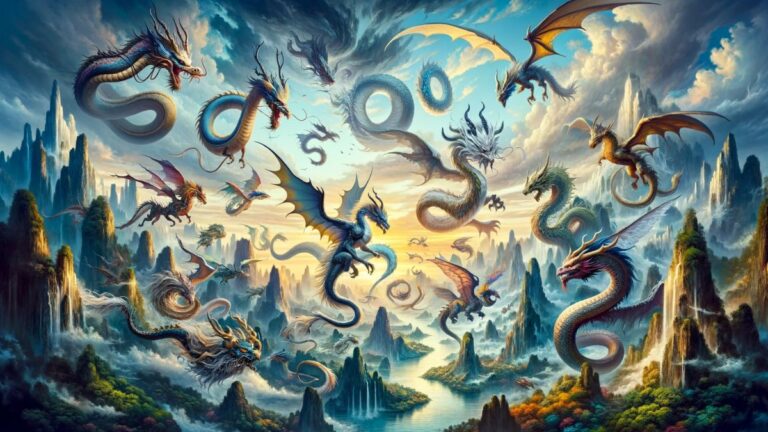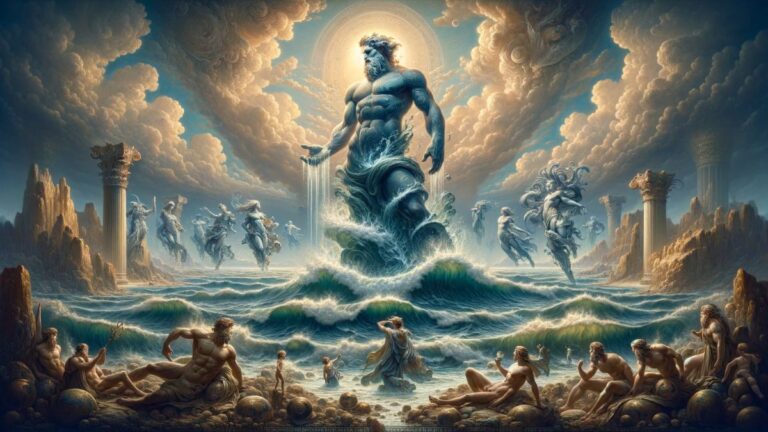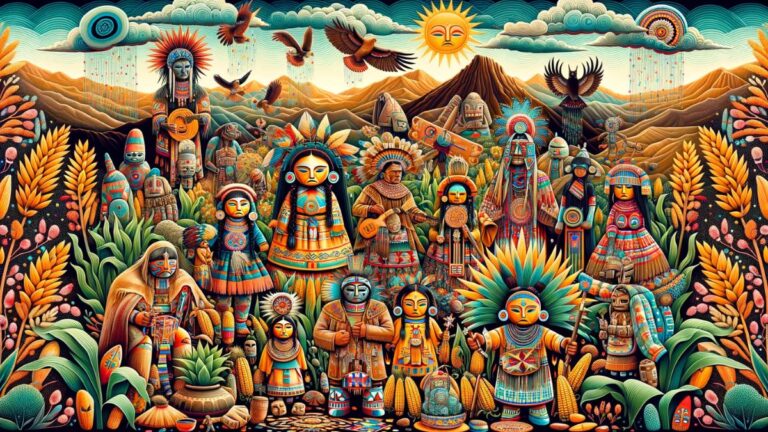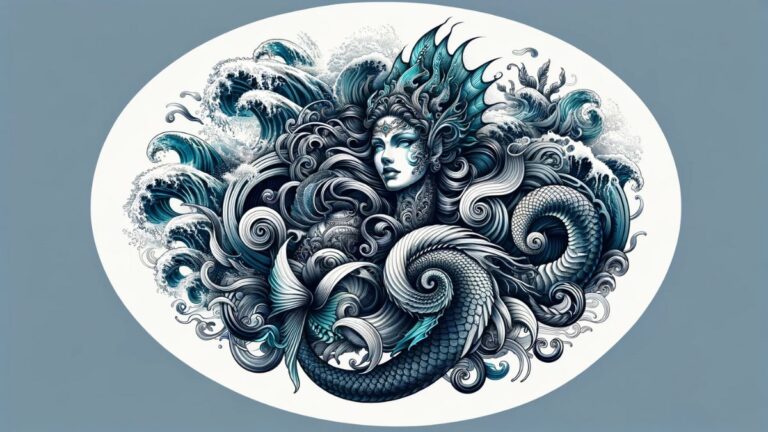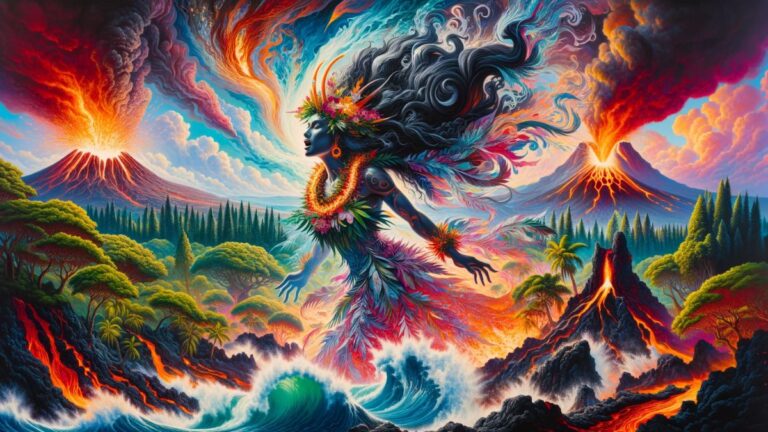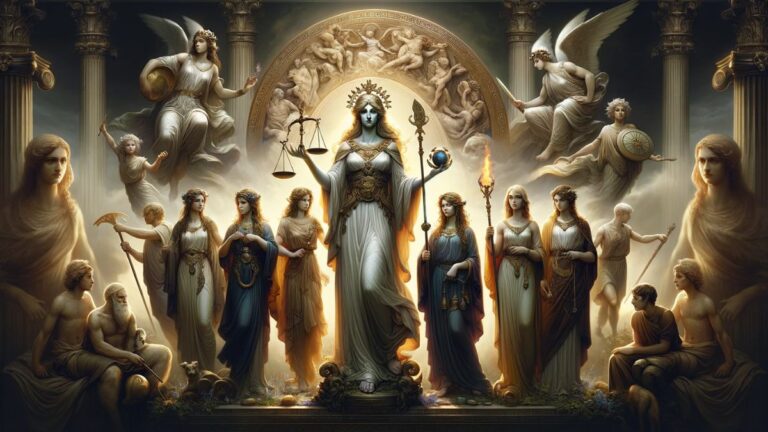All Mythical Creatures from A to Z: Discover Their Hidden Mysteries!
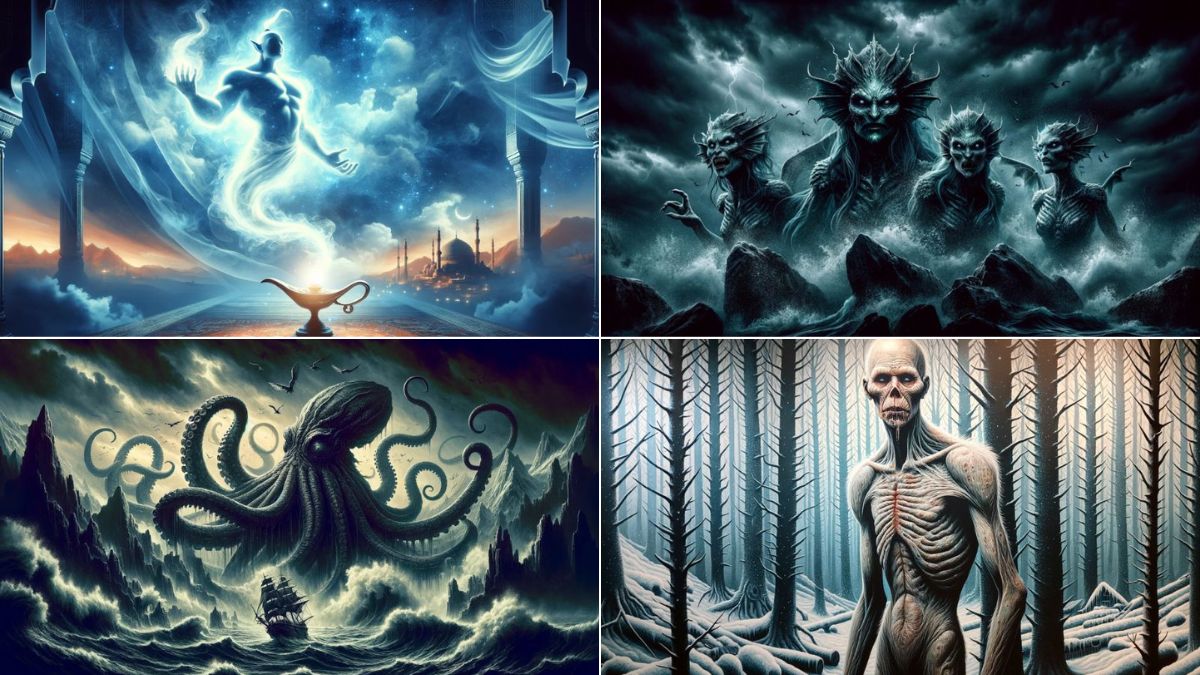
Embark on an enchanting journey through the alphabet of myth and legend. In this article, we dive into the world of mythical creatures, sorting them meticulously from A to Z. While the realm of mythology is vast, encompassing thousands of beings from diverse cultures, we’ll be focusing on the most significant ones from major mythologies. From the mighty dragons to the elusive unicorns, each creature carries a tale that ignites our imagination and lures us into the realms of the unknown. Although we can’t cover every mythical being, the ones we do explore represent the rich tapestry of global folklore. So, get ready to embark on a fascinating adventure and discover the captivating stories of these legendary entities!
Amphisbaena
Mythology: Greek
The Amphisbaena is a serpent with two heads, one at each end of its body, from Greek mythology. Born from the blood of Medusa, this creature could move in any direction and was feared for its deadly nature. It was, however, sometimes seen as a protective charm, especially among travelers. The Amphisbaena represents the dual nature of life, embodying both danger and protection.
Aswang
Mythology: Philippine
An Aswang is a shape-shifting monster in Philippine folklore. It’s feared for its predatory nature, often transforming into animals or other humans to deceive its victims. By day, Aswangs appear as regular townsfolk, but at night, they hunt for prey, particularly preferring to feast on unborn fetuses and small children. They embody the fear of the unknown and the duality of human nature.
Aatxe
Mythology: Basque
The Aatxe is a spirit from Basque mythology, often taking the form of a young red bull, but capable of human shape-shifting. This creature emerges at night, especially during stormy weather, and is known to protect the people and the land. The Aatxe is a guardian spirit, symbolizing the forces of nature and the protection of sacred spaces. It embodies the Basque culture’s deep respect for nature and the supernatural.
Abarimon
Mythology: Medieval Legends
Abarimon is a legendary race of people from medieval lore, inhabiting a valley in the Himalayas. Known for their unique feet, which are turned backwards, they are said to be incredibly fast and able to live in harmony with wild animals. Abarimon represents the fascination with the unknown and unexplored parts of the world, symbolizing the diverse and wondrous possibilities of human existence.
Achiyalabopa
Mythology: Pueblo Native American
Achiyalabopa, in Pueblo Native American mythology, are birds with feathers made of knives. They are known for their beautiful, yet dangerous appearance. Often featured in tales that warn against vanity and pride, Achiyalabopa represents the dual nature of beauty—both alluring and perilous, symbolizing the idea that something attractive can also be harmful.
Adze
Mythology: Ewe (West African)
An Adze is a vampire-like creature in Ewe folklore, which takes the form of a bat. It feeds on humans, especially children, by transforming into a human at night. The Adze embodies the fear of the unknown and the dangers lurking in the dark, representing the anxieties and superstitions inherent in human societies.
Bunyip
Mythology: Australian Aboriginal
The Bunyip is a creature from Australian Aboriginal mythology, said to lurk in swamps, billabongs, creeks, riverbeds, and waterholes. Descriptions vary widely, but it’s often portrayed as a fearsome creature. The Bunyip represents the unknown dangers of the Australian landscape, symbolizing the natural caution against unseen threats in unfamiliar environments.
Brownie
Mythology: Scottish
Brownies are benevolent household spirits from Scottish folklore, resembling small, wizened men. They secretly help with household chores at night in exchange for small gifts or food. Brownies embody the spirit of helpfulness and the unobserved assistance that keeps a household running smoothly. They are often associated with the rewarding nature of quiet, selfless work.
Baku
Mythology: Japanese
Baku are supernatural beings in Japanese folklore, believed to devour nightmares. These creatures are depicted with a chimera-like appearance, combining elements of different animals. Calling upon a Baku after a bad dream is thought to protect the individual from misfortune. They symbolize the protection against the unknown and the power of good spirits to ward off evil.
Baba Yaga
Mythology: Slavic
Baba Yaga is a notorious figure in Slavic folklore, often depicted as a fearsome witch with a penchant for eating those who displease her. She dwells in a hut that stands on chicken legs and is both feared and revered. Baba Yaga is a complex character, sometimes helping those who seek her out, albeit in her peculiar and testing way. She represents the unpredictable nature of fate and the dual aspects of wisdom and danger.
Banshee
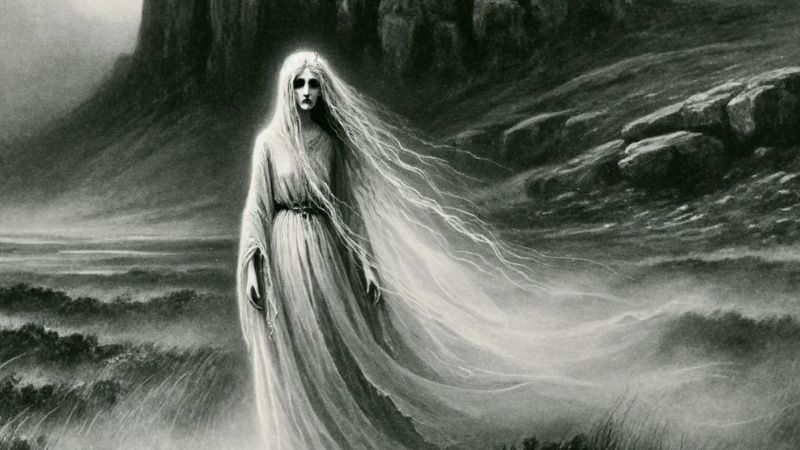
Mythology: Irish
A Banshee is a supernatural being in Irish folklore, often depicted as a wailing woman. Her mournful cry is believed to be an omen of death in the family. Traditionally, the Banshee’s appearance varies from a young woman to an old hag, and her presence is both feared and respected. She represents the connection between the mortal world and the spiritual realm.
Basilisk
Mythology: European
The Basilisk, known as the “King of Serpents,” is a legendary creature that could kill with a mere glance. Originating in European folklore, it was said to be hatched by a serpent from a chicken’s egg. The Basilisk’s lethal gaze and venom made it a fearsome creature. It could, however, be defeated by a rooster’s crow or by seeing its own reflection.
Centaur
Mythology: Greek
Centaurs are mythical creatures with the upper body of a human and the lower body of a horse. They are from Greek mythology and are known for their dual nature, embodying both the civilized and wild aspects of humanity. Centaurs are often depicted in myths as wild and unruly, but also wise and noble, like the famous Centaur Chiron, who was a teacher of many heroes.
Chimera
Mythology: Greek
The Chimera is a monstrous creature from Greek mythology, described as a hybrid of a lion, goat, and serpent. This creature breathed fire and was a formidable opponent in myths. The Chimera represents the fearsome and unpredictable nature of the world, a symbol of the hybridization of different forms and the chaos it can bring.
Cipactli
Mythology: Aztec
Cipactli, in Aztec mythology, is a sea monster, part crocodile, part fish, and part frog. It’s said to have been used by the gods to create the Earth from its body. Cipactli represents the chaotic primordial world before creation, embodying the concepts of creation and destruction. This creature symbolizes the Aztec understanding of the interconnectedness of the earth and the divine.
Cacus
Mythology: Roman
Cacus is a fire-breathing giant and the son of Vulcan in Roman mythology. Known for his terrorizing of the Aventine Hill before being slain by Hercules, Cacus represents the brute, untamed forces of nature and the hero’s journey to overcome such monstrous adversaries. His story is a classic tale of good versus evil, highlighting the virtues of courage and strength.
Cuélebre
Mythology: Asturian and Cantabrian
Cuélebre are dragon-like creatures in Asturian and Cantabrian mythology. They are often depicted as huge, winged serpents that live in caves, where they guard treasure. Over time, they grow moss and trees on their scales. Cuélebre represents the awe and fear of the unknown and the natural tendency to embellish tales over generations, symbolizing the richness of regional folklore.
Chaneque
Mythology: Aztec
Chaneques are small, sprite-like beings in Aztec mythology, guardians of nature. They’re believed to dwell in forests and mountains, protecting wildlife. Chaneques are known to bewitch humans, leading them to lose their souls. They symbolize the respect and reverence for nature, as well as the dangers of disrespecting the natural world.
Djinn
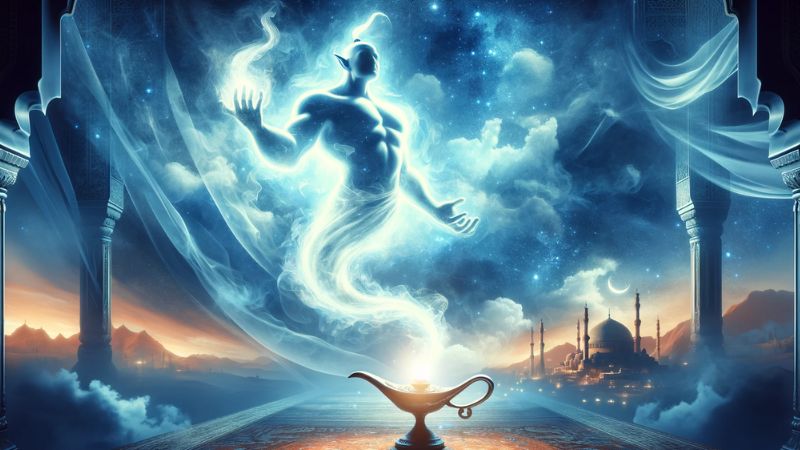
Mythology: Middle Eastern
Djinn, or genies, are supernatural beings in Middle Eastern folklore. They are known for their ability to grant wishes, but also for their trickery and unpredictable nature. Djinn can be benevolent, malevolent, or neutral, and they possess free will. These beings are often associated with the elements and have a deep connection to the spiritual world.
Drekavac
Mythology: Slavic
Drekavac, from Slavic folklore, is a creature associated with the souls of unbaptized children. It’s depicted as having a disturbing cry and can appear in various forms. Drekavac stories are often used as cautionary tales to keep children away from dangerous areas. It embodies the cultural fears surrounding the unknown and the importance of religious and social rites.
Dullahan
Mythology: Irish
The Dullahan is a type of unseelie fairy in Irish folklore, often depicted as a headless rider on a black horse, carrying their head under one arm. Known for heralding death, the Dullahan roams the countryside at night. They embody the inevitability of death and the fear associated with it, representing a bridge between the living world and the afterlife.
Dybbuk
Mythology: Jewish
A Dybbuk is a malicious spirit in Jewish mythology, believed to be the dislocated soul of a dead person. It supposedly possesses the living to accomplish unfinished tasks. The concept of the Dybbuk reflects the complexities of the spiritual world in Jewish folklore, where spirits can interact with the living in profound ways. It symbolizes unresolved issues and the influence of the past on the present.
Dragon
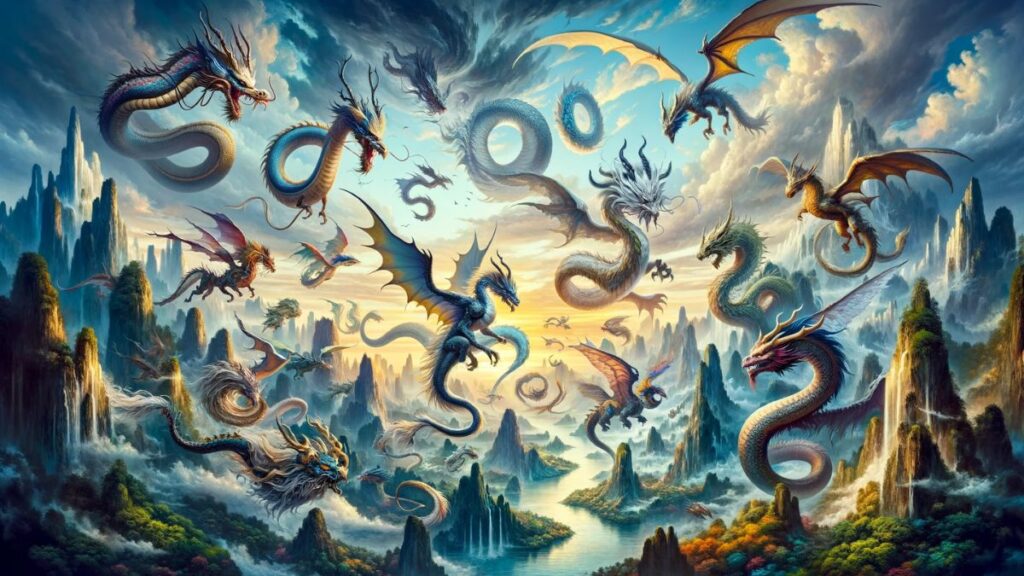
Mythology: Worldwide
Dragons are among the most iconic and universally recognized mythical creatures, appearing in cultures all around the world. In Western mythology, dragons are often depicted as large, fire-breathing reptiles, embodying chaos and danger, and are typically seen as adversaries to be defeated by heroes. In contrast, Eastern dragons are usually seen as benevolent and wise, associated with water, rainfall, and good fortune. These majestic creatures symbolize a myriad of concepts including power, wisdom, and the primal forces of nature. The dragon’s appeal lies in its mysterious and powerful nature, captivating human imagination across different cultures and ages.
Elf
Mythology: Germanic and Norse
Elves are enchanting beings from Germanic and Norse folklore, often depicted as youthful and immortal with magical powers. Inhabiting forests, meadows, or sea areas, they are known for their beauty and are either benevolent or mischievous. Elves have become a staple in modern fantasy, varying greatly in depiction, from the wise and noble beings in high fantasy to the playful and tricky characters in folk tales.
Echidna
Mythology: Greek
Echidna, in Greek mythology, is a monster described as half-woman, half-snake. Known as the “Mother of Monsters,” she gave birth to many of the famous Greek mythical beasts, including the Chimera and Cerberus. Echidna represents the earth’s raw and untamed nature, embodying the chaos and danger lurking in its depths. Her role as a mother of monsters symbolizes the birth of fears and challenges.
Ebu Gogo
Mythology: Flores, Indonesia
Ebu Gogo are mythical creatures from the island of Flores in Indonesia, described as small, ancient humanoids. They are known in local folklore for their mischievous behavior and interaction with early human settlers. Ebu Gogo symbolizes the human connection with our ancient past and the mysteries surrounding human evolution and early civilization.
Enfield
Mythology: Irish
The Enfield is a mythical creature with the head of a fox, the forelegs of an eagle, the body of a lion, and the hindquarters of a wolf. Found in Irish heraldry, it symbolizes loyalty and protection. The Enfield represents the bravery and strength found in combining the attributes of various creatures, embodying the idea of unity in diversity.
Fossegrim
Mythology: Norse
Fossegrim, also known as Fossergrim, is a water spirit in Norse mythology. Known for playing enchanting music on a fiddle, he resides in waterfalls and teaches music to those who offer him gifts. Fossegrim represents the beauty and inspiration found in nature and the arts, symbolizing the connection between the natural world and cultural expression.
Faun
Mythology: Roman
Fauns are Roman mythological creatures with the body of a man and the legs and horns of a goat. Similar to Greek satyrs, they embody the spirit of the forest and rustic nature. Fauns are known for their playful and mischievous behavior, often associated with the natural world and its untamed qualities. They symbolize the wild, untamed aspects of nature and humanity.
Fenrir
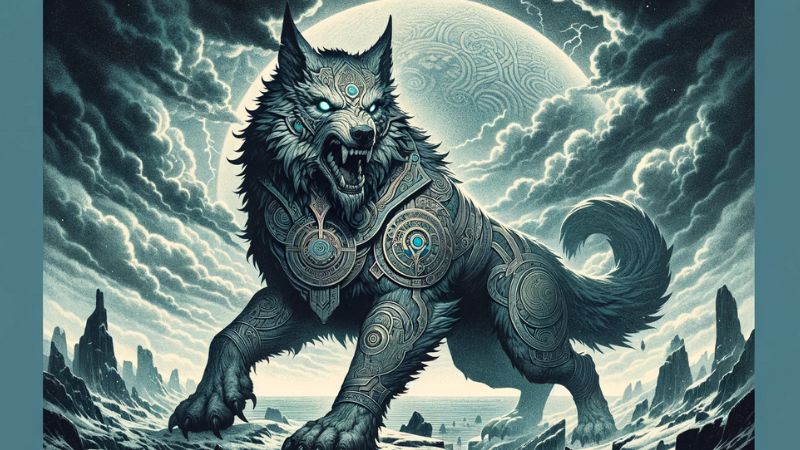
Mythology: Norse
Fenrir is a monstrous wolf from Norse mythology, foretold to play a major role in Ragnarok, the end of the world. The son of the god Loki and the giantess Angrboda, Fenrir’s strength was feared by the gods, leading them to bind him. Fenrir symbolizes the untamable forces of nature and the inevitability of fate, representing the fear of the unknown and the power of destiny.
Glaistig
Mythology: Scottish
The Glaistig is a mythical creature from Scottish folklore, a type of ghost or fairy, often described as a beautiful woman with a goat’s lower half. She is known for her dual nature, both protecting and harming humans, particularly in or near water. The Glaistig symbolizes the duality of nature – nurturing yet dangerous, and the blurred lines between the human world and the supernatural.
Gorgon
Mythology: Greek
The Gorgons, in Greek mythology, are female creatures with hair made of living, venomous snakes, and a gaze that turns those who look upon them to stone. The most famous Gorgon, Medusa, was slain by the hero Perseus. Gorgons represent the concept of the deadly and the alluring intertwined, embodying the dangers hidden beneath surface beauty and the power of the divine feminine.
Grendel
Mythology: Anglo-Saxon
Grendel is a creature from Anglo-Saxon mythology, famously appearing in the epic poem “Beowulf.” Described as a monstrous being, Grendel terrorizes the mead hall of King Hrothgar before being defeated by Beowulf. Grendel represents the external and internal battles one faces, symbolizing the darkness that lurks on the fringes of human society and within human nature.
Griffin

Mythology: Ancient Middle Eastern and Mediterranean
The Griffin is a legendary creature with the body of a lion and the head and wings of an eagle. It’s found in various ancient Middle Eastern and Mediterranean myths. Griffins are known as guardians of treasures and are symbols of divine power and majesty. Their dual nature, combining the king of beasts and the king of birds, represents strength and wisdom.
Haetae
Mythology: Korean
Haetae is a mythical creature in Korean folklore, often depicted as a lion-like figure with horned scales. Known for its ability to judge between good and evil, Haetae is said to protect against fire and disasters. It represents discernment and protection, symbolizing the need for balance and wisdom in overcoming adversity.
Harpy
Mythology: Greek
Harpies are winged spirits in Greek mythology, often depicted as birds with the heads of women. They are known for their swift flight and are often associated with the wind. Harpies are typically seen as agents of punishment who snatch away people and things. They symbolize the sudden, uncontrolled forces of nature and the fear of being carried away by one’s emotions.
Hippogriff
Mythology: European
The Hippogriff is a legendary creature, part horse and part griffin, with the front quarters of an eagle and the hind quarters of a horse. Originating in European folklore, it symbolizes the impossible or the highly improbable, bridging the gap between reality and fantasy. The Hippogriff represents the merging of two distinct realms or ideas into a powerful and majestic entity.
Huldra
Mythology: Scandinavian
Huldra are seductive forest creatures found in Scandinavian folklore. They appear as stunningly beautiful women, often with a cow’s tail or a fox’s tail, and can either be benevolent or malevolent towards humans. Huldra are known to lure men into the forest to either marry them or punish them. They represent the allure and danger of the wilderness, symbolizing the mysteries and untamed aspects of nature.
Ijiraq
Mythology: Inuit
The Ijiraq is a shape-shifting creature in Inuit mythology. It kidnaps children who wander away, hiding them away in the spirit world. Parents must perform specific rituals to retrieve their children. The Ijiraq symbolizes the dangers of straying too far from home and the protective instincts of parents. It represents the fine line between the real world and the spiritual realm.
Iara
Mythology: Brazilian
Iara, also known as the Lady of the Waters, is a figure from Brazilian mythology. She is a beautiful mermaid-like creature with green hair and fair skin, known to reside in rivers. Iara lures men with her enchanting voice, leading them to live with her underwater. She embodies the seductive allure of nature and the peril that comes with succumbing to temptation.
Imp
Mythology: Germanic
Imps are small, mischievous creatures from Germanic folklore. They are often depicted as lesser demons or fairy-like beings, known for their playful and sometimes malevolent behavior. Imps are typically associated with trickery and pranks, often causing trouble for humans. Despite their sometimes sinister antics, imps are not usually seen as evil, but rather as playful spirits of the natural world.
Inkanyamba
Mythology: South African
Inkanyamba is a legendary serpent in South African folklore, believed to reside in lakes and rivers, particularly in the Howick Falls. It’s often associated with violent storms. Inkanyamba is revered and feared, embodying the untamed power of nature and the mysteries lurking in the depths of water bodies. It represents the awe and respect that natural phenomena inspire in humans.
Jackalope
Mythology: North American Folklore
The Jackalope is a mythical animal in North American folklore, depicted as a rabbit with antelope horns. Known for its mischievous behavior, the Jackalope is a playful creation of American folklore, blending reality and fantasy. It symbolizes the whimsical nature of folk tales and the joy in blending imagination with elements of the natural world.
Jinni
Mythology: Arabian
Jinni, or genies, are supernatural beings from Arabian mythology. Similar to Djinn, they possess free will and can be good, evil, or neutrally inclined. Jinni are known for their ability to shape-shift and their connection to magical realms. They are often associated with elemental forces and are deeply rooted in the spiritual and mystical aspects of the world.
Jörmungandr
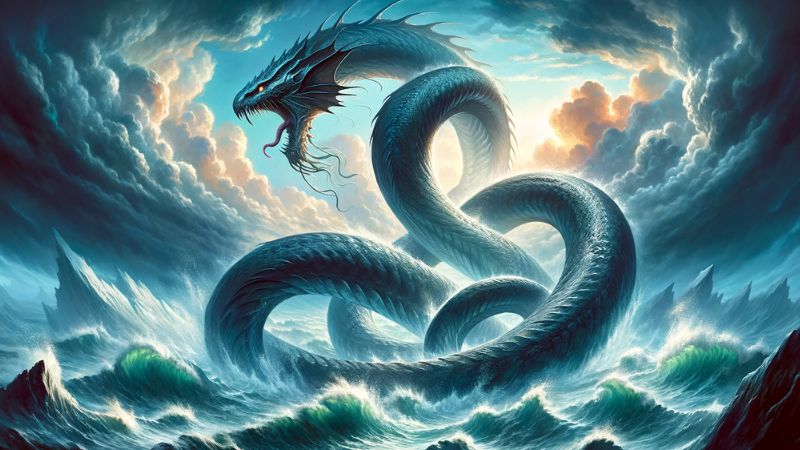
Mythology: Norse
Jörmungandr, the Midgard Serpent, is a sea serpent in Norse mythology. This immense creature encircles the Earth, biting its own tail. Jörmungandr is a key figure in the events leading to Ragnarok, where it’s destined to battle Thor. It symbolizes the cyclical nature of the world, the interconnectedness of all things, and the constant presence of chaos lurking just beneath the surface of order.
Jorogumo
Mythology: Japanese
Jorogumo is a mythical creature from Japanese folklore, a spider that can transform into a beautiful woman. Often depicted as luring men to her lair and binding them in her webs, the Jorogumo represents deception and the dangers lurking beneath beautiful exteriors. It embodies the theme of entrapment by one’s desires and the consequences of succumbing to temptation.
Kelpie
Mythology: Scottish
Kelpies are shape-shifting water spirits in Scottish folklore, often appearing as horses. They are known to lure people, especially children, onto their backs for a ride, only to drag them into the water and drown them. Kelpies symbolize the perilous and unpredictable nature of water, representing the cautionary tales told to keep children away from dangerous waters.
Kappa
Mythology: Japanese
Kappa are water creatures from Japanese folklore, resembling human-like turtles. Known for their mischievous behavior, they inhabit rivers and ponds. Kappa are both revered and feared; they can be malevolent towards humans but can also bring benefits, like teaching medical cures. They embody the dual nature of water as both life-giving and dangerous, representing respect for the natural world and its hidden depths.
Kraken
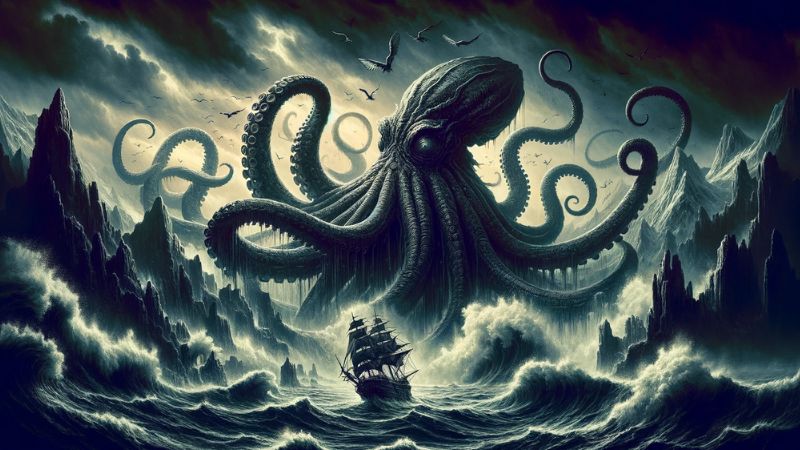
Mythology: Norse
The Kraken is a legendary sea monster from Norse mythology, often described as a giant octopus or squid. It’s feared by sailors for its ability to create whirlpools and sink ships. The Kraken represents the unknown terrors of the ocean depths and the power of nature, embodying the fear and awe that the sea has inspired in people throughout history.
Knucker
Mythology: English
Knuckers are mythical water dragons from English folklore, residing in knuckerholes, or deep pools. Known for their interactions with humans, sometimes benevolent and other times malevolent, Knuckers are often outwitted by cunning individuals. They symbolize the mysteries of the natural world and the idea that wit and intelligence can overcome brute strength.
Lusca
Mythology: Caribbean
The Lusca is a sea monster in Caribbean folklore, often described as a giant octopus or a multi-headed creature. Said to lurk in the blue holes of the Bahamas, it drags unsuspecting swimmers into its lair. The Lusca embodies the fear of the unknown depths of the ocean, representing the mysteries and dangers hidden beneath the surface of the sea.
Leprechaun
Mythology: Irish
Leprechauns are small, bearded men from Irish folklore, often dressed in green coats and known for their mischievous behavior. They are commonly associated with pots of gold at the end of rainbows and are skilled cobblers. Leprechauns are elusive and tricky, known for playing pranks on humans. They symbolize luck and fortune, and their stories often contain moral lessons about the dangers of greed.
Lamassu
Mythology: Mesopotamian
Lamassu are protective deities from ancient Mesopotamian religion, depicted as having a human head, the body of a bull or lion, and bird wings. They were often placed at city gates and entrances as guardians. Lamassu symbolize power, protection, and the divine right of kings, representing the intersection of the human, animal, and divine realms.
Leshy
Mythology: Slavic
The Leshy is a forest spirit in Slavic mythology, a protector of the animals and the forest. It’s capable of changing size and shape. The Leshy leads travelers astray, making them lost in the forest, but can also guide them out if respected. The Leshy embodies the spirit of the forest, symbolizing the importance of respecting nature and understanding its many facets.
Mngwa
Mythology: Tanzanian
The Mngwa, or Nunda, is a cryptid from Tanzanian folklore, described as a large, ferocious, and mysterious feline creature. It’s feared by locals and is said to be more dangerous than a lion or leopard. The Mngwa represents the fear of the unknown and the mysteries that lurk in the unexplored regions of the world.
Manticore
Mythology: Persian
The Manticore is a mythical beast from Persian legend, described as having the body of a lion, a human head with three rows of sharp teeth, and a tail tipped with venomous spines. It’s known for its ferocity and appetite for human flesh. The Manticore represents the ultimate predator, embodying fear and the unknown, and is often used in stories and art as a symbol of the power and danger of the wild.
Mokèlé-mbèmbé
Mythology: Central African
Mokèlé-mbèmbé, meaning “one who stops the flow of rivers” in Lingala, is a cryptid from Central African folklore, often described as a dinosaur-like creature. It’s said to inhabit the Congo River Basin. This creature represents the unexplored and mysterious nature of the world’s densest jungles and the fascination with prehistoric life persisting in modern times.
Nøkk
Mythology: Scandinavian
Nøkk are shape-shifting water spirits in Scandinavian folklore, often taking the form of a horse or a man. They lure their victims into the water with enchanting music or appearance. Nøkk symbolize the danger and allure of natural bodies of water, representing the ancient belief in the spirits that inhabit and personify nature’s elements.
Naga
Mythology: Hindu and Buddhist
Nagas are serpent-like beings in Hindu and Buddhist mythology. They are powerful and mystical, often associated with water bodies like rivers and seas. Nagas are revered as protectors and guardians of treasures. They symbolize the balance of good and evil, with their benevolent nature often juxtaposed against their potential for wrath and vengeance.
Nemean Lion
Mythology: Greek
The Nemean Lion is a legendary creature in Greek mythology, known for its impenetrable hide and immense strength. It was slain by Heracles (Hercules) as his first labor. The Nemean Lion symbolizes the ultimate challenge or obstacle, representing the hero’s journey and the triumph over seemingly insurmountable trials.
Nuckelavee
Mythology: Orcadian
The Nuckelavee is a malevolent sea spirit from Orcadian mythology, with origins in Norse mythology. This creature is horse-like but shares some humanoid characteristics and is known for its terrible and fearsome nature. It’s believed to bring diseases to crops and livestock. The Nuckelavee symbolizes the destructive aspects of the ocean and nature’s uncontrollable and devastating power.
Ouroboros
Mythology: Ancient Egyptian and Greek
The Ouroboros is an ancient symbol depicting a serpent or dragon eating its own tail. Originating in Egyptian iconography and adopted by Greek magical tradition, it represents the eternal cycle of renewal, the infinite nature of time, and the continuous creation and destruction of the universe. The Ouroboros embodies the concept of self-sufficiency and the cyclic nature of life.
Ogre
Mythology: European
Ogres are large, fearsome creatures found in European folklore. They are often depicted as having a voracious appetite, especially for humans. Despite their brute strength and terrifying demeanor, ogres are sometimes portrayed as lacking in intelligence. They symbolize physical power and the primal fears of being consumed or overpowered.
Ondine
Mythology: European
Ondines, also known as undines, are water nymphs in European folklore. They are beautiful female spirits of the water, often associated with lakes and streams. Ondines are said to gain a soul by marrying a human and bearing his child, but this union often comes with tragic consequences. They represent the mystical and elusive nature of water, embodying themes of love, loss, and the blending of the natural and human worlds.
Orang Bunian
Mythology: Malay
Orang Bunian are supernatural beings in Malay folklore, invisible to most humans but similar to them in appearance. They are known to live in deep forests or high mountains, often intermingling with humans and influencing their lives. Orang Bunian represent the unseen forces and mysteries surrounding traditional Malay life, embodying the coexistence of the human and spiritual worlds.
Púca
Mythology: Irish
Púca, or Pooka, are shape-shifting creatures from Irish folklore, known to change into various animal forms, often a horse, goat, or hare. They are tricksters by nature, sometimes helping humans and other times leading them astray. Púca represent the unpredictability of nature and fate, embodying the idea that not all supernatural encounters are either wholly good or entirely bad.
Phoenix
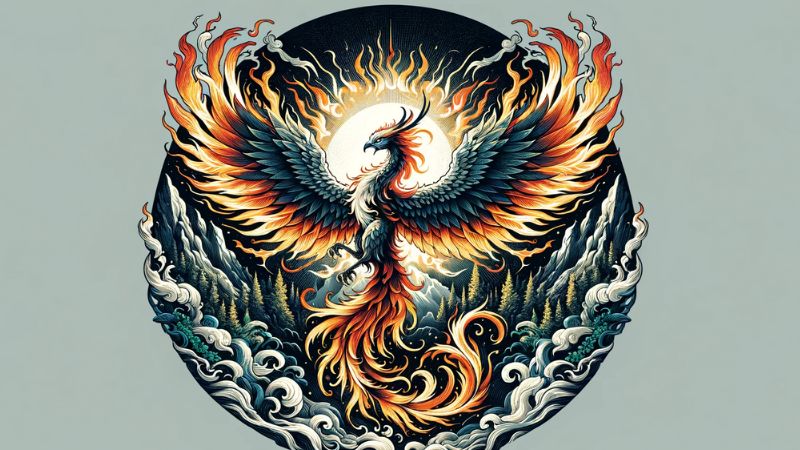
Mythology: Greek and Asian
The Phoenix is a mythical bird known for its cycle of rebirth. Associated with the sun, it dies in a show of flames and combustion, only to be reborn from its ashes. Found in both Greek and Asian cultures, the Phoenix symbolizes renewal, immortality, and the enduring nature of life. It represents hope, resilience, and the idea that something beautiful can arise from destruction and chaos.
Pegasus
Mythology: Greek
Pegasus is a magnificent winged horse from Greek mythology, born from the blood of Medusa when Perseus beheaded her. It symbolizes freedom, inspiration, and the soaring spirit. Pegasus is often depicted as a helper of heroes, assisting them in conquering formidable challenges. He represents the power of imagination and the liberation from earthly constraints.
Piasa
Mythology: Native American
The Piasa is a mythical creature from Native American folklore, particularly of the Illini tribe. Depicted as a bird-like dragon with a man’s face, it’s said to have lived along the Mississippi River. The Piasa was feared for its alleged appetite for humans. It symbolizes the mysteries and dangers of the natural world, representing the storytelling tradition that connects communities with their environment.
Qiqirn
Mythology: Inuit
The Qiqirn is a creature from Inuit mythology, described as a large, hairless dog. It’s known to cause fear and disorientation in those who encounter it. The Qiqirn represents the hazards and disorienting aspects of the Arctic environment, embodying the fears and uncertainties that come with living in such harsh and remote areas.
Qareen
Mythology: Islamic
In Islamic mythology, a Qareen is a type of personal spirit or demon. Each person is believed to have their own Qareen, which can influence them either towards good or evil. The Qareen is a companion throughout a person’s life, symbolizing the internal struggle between one’s higher aspirations and baser instincts, reflecting the concept of moral duality and personal choice.
Qilin
Mythology: Chinese
The Qilin, in Chinese mythology, is a hooved chimerical creature known for its gentleness and benevolence. It is often depicted with a dragon-like head and covered with brilliant, flame-like scales. The Qilin is a symbol of good luck, prosperity, and serenity, and its appearance is said to foretell the birth or death of a sage or illustrious ruler.
Quetzalcoatl
Mythology: Mesoamerican
Quetzalcoatl, known as the “Feathered Serpent,” is a deity from Mesoamerican culture. He is associated with the wind, air, and learning, and is one of the major deities of ancient Mesoamerican civilizations. Quetzalcoatl is often depicted as a mix of bird and rattlesnake and is seen as a creator deity and a symbol of the unification of earth and sky.
Roc
Mythology: Middle Eastern
The Roc is an enormous legendary bird of prey in Middle Eastern mythology, often described as large enough to carry off fully grown elephants. It appears in several Arabian fairy tales and travel narratives. The Roc symbolizes immense strength and is often associated with the dangers and wonders of exotic lands. It represents the awe and fear inspired by nature’s power and scale.
Rusalka
Mythology: Slavic
Rusalka are water nymphs in Slavic folklore, often depicted as beautiful young women inhabiting lakes or rivers. They are known for their enchanting singing and dancing, which can lure men to their deaths. Rusalka represent the beauty and danger of the natural world, embodying the mystery and allure of water, as well as the peril that it can pose.
Rompo
Mythology: African and Indian
The Rompo is a mythical beast found in African and Indian folklore, described as having the head of a hare, the arms of a badger, and the tail of a bear. It’s known for feeding on human corpses. The Rompo symbolizes the fear of the unknown and the blending of various elements into a single, mysterious entity, representing the diverse and rich tapestry of African and Indian mythologies.
Strzyga
Mythology: Slavic
The Strzyga is a demonic creature in Slavic folklore, resembling a human with two souls and two sets of teeth. When one soul dies, the Strzyga becomes a bloodthirsty being, preying on humans and animals. It represents the duality of human nature and the fear of the unknown, symbolizing the darker aspects of folklore where morality and mortality intertwine.
Selkie
Mythology: Celtic and Norse
Selkies are mythological beings found in Celtic and Norse folklore, capable of transforming from seals into humans. They are known for their beauty and the tragic tales of their human lovers. Selkies symbolize the longing for what is lost, the dual nature of identity, and the eternal dilemma between the call of the ocean and the land.
Siren
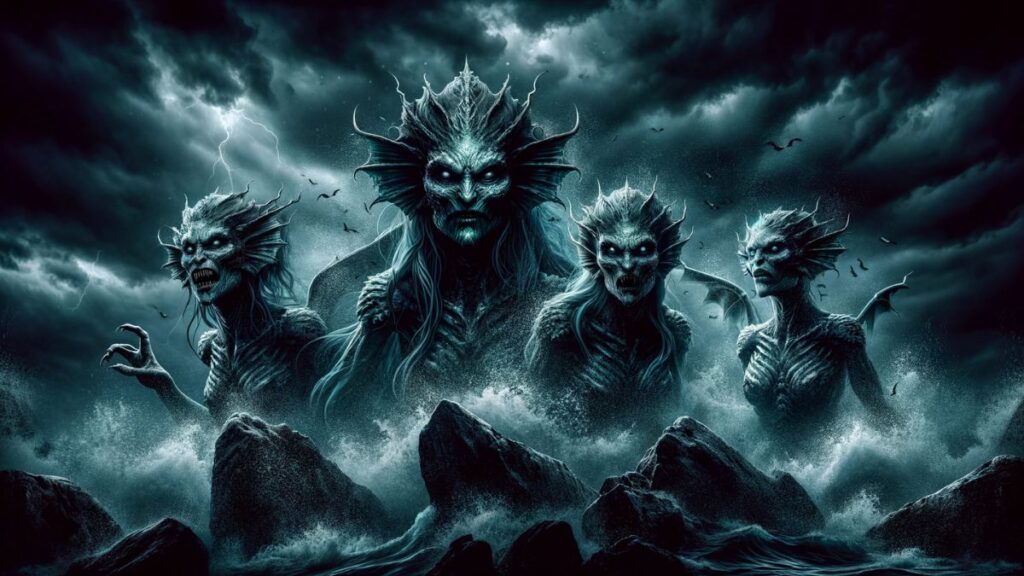
Mythology: Greek
Sirens in Greek mythology are creatures with the head and torso of a woman and the body of a bird. Known for their enchanting song, Sirens lure sailors to their doom on treacherous rocks. Their captivating music symbolizes temptation and the dangers that lurk beneath alluring facades. Sirens represent the conflict between desire and the perilous journey of navigating life’s treacherous paths.
Simurgh
Mythology: Persian
The Simurgh is a mythical bird in Persian folklore, similar to a phoenix. It’s often depicted as a large, beautiful bird with a long tail. The Simurgh is said to possess immense wisdom and knowledge, living for many centuries. It symbolizes healing and salvation, often featured in stories where its intervention is crucial to resolving dire situations.
Tikbalang
Mythology: Philippine
Tikbalang are mythical creatures in Philippine folklore, described as humanoid figures with the head and feet of a horse. They are known to lurk in the forests and mountains, leading travelers astray or causing them to lose their way. Tikbalang symbolizes the dangers of wandering into unknown territories and the mischievous nature of some mythical beings.
Troll
Mythology: Norse
Trolls are mythical beings from Norse mythology, typically depicted as large, brutish creatures that dwell in isolated rocks, mountains, or caves. They are known for their strength, slow wits, and aversion to sunlight, which can turn them to stone. Trolls play a significant role in many folk tales and legends, often as antagonists to human characters. They symbolize the wild and uncivilized aspects of nature and the unknown.
Tengu
Mythology: Japanese
Tengu are supernatural creatures from Japanese folklore, often depicted as bird-like humanoids with long noses. They are known to be skilled warriors and are sometimes revered as protectors of the mountains and forests. Tengu represent the connection between the physical and spiritual worlds, embodying both protective qualities and a mischievous nature, often testing and teaching valuable lessons to those who enter their domain.
Taniwha
Mythology: Māori
Taniwha are powerful beings in Māori mythology, often appearing as dragons or large water monsters. They are considered guardians of waterways, providing protection but also posing danger. Taniwha symbolize the respect and reverence Māori culture holds for natural landmarks and water bodies, embodying the spiritual connection between the physical landscape and its inhabitants.
Uchchaihshravas
Mythology: Hindu
Uchchaihshravas is a seven-headed flying horse in Hindu mythology, emerging from the churning of the ocean of milk. It’s known for its pure white color and is often associated with the gods. Uchchaihshravas represents purity, wisdom, and the quest for immortality, symbolizing the rich and complex narratives of Hindu mythology and the pursuit of spiritual enlightenment.
Unicorn
Mythology: Worldwide
The Unicorn is a legendary creature resembling a horse with a single, spiraled horn projecting from its forehead. Seen in various cultures around the world, it is often a symbol of purity and grace. In some legends, only a virgin can capture a unicorn. The unicorn represents the pursuit of the unattainable and the beauty of the untamed wild.
Urayuli
Mythology: Alaskan Native
Urayuli, or “Hairy Men”, are cryptid creatures from Alaskan Native folklore. Described as tall, hairy, and humanoid, they are said to emit a mournful, woeful sound. Urayuli are typically associated with the wilderness and remote areas. They represent the mysteries and fears of the vast, unexplored wilds of Alaska, embodying the natural and supernatural elements of the region’s lore.
Vampire
Mythology: Slavic and European
Vampires are mythical creatures from Slavic and European folklore, known for feeding on the blood of the living. Often depicted as undead beings, vampires are both feared and romanticized. They have become a significant part of popular culture, symbolizing seduction, the fear of the unknown, and the duality of human nature – the struggle between the primal, monstrous side and the sophisticated, human aspect.
Valkyrie
Mythology: Norse
Valkyries are female figures in Norse mythology who choose those who may die in battle and those who may live. They are known as choosers of the slain, serving the god Odin. Valkyries are often depicted as fierce and powerful, representing the intricate relationship between life and death, war and fate, and the honor and glory of the afterlife in Valhalla.
Vættir
Mythology: Norse
Vættir are spirits or supernatural beings in Norse mythology, associated with the natural elements like land, water, and trees. They are protectors of their respective realms, and Norse people would often make offerings to them for protection and good fortune. Vættir symbolize the deep connection between the natural world and the spiritual, emphasizing the importance of respecting and coexisting with nature.
Veo
Mythology: Indonesian
The Veo is a giant creature from Indonesian folklore, often depicted as a massive serpent or dragon. It’s said to inhabit the deep seas and controls the water. The Veo embodies the power and mystery of the ocean, representing the vast and unexplored territories that have always fascinated and intimidated humankind.
Wendigo
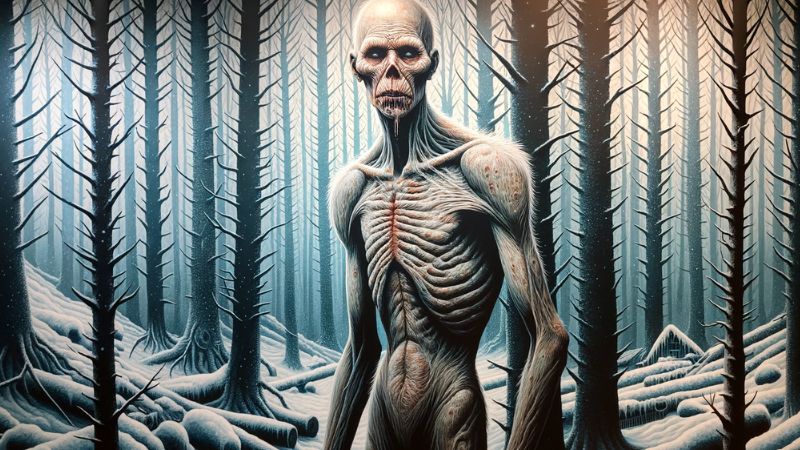
Mythology: Algonquian
The Wendigo is a malevolent spirit from Algonquian folklore, associated with winter, cold, famine, and starvation. It’s often depicted as a monstrous creature, driven by insatiable greed and gluttony. The legend of the Wendigo serves as a cautionary tale against excess and moral taboos, embodying the destructive nature of greed and the primal fear of cannibalism.
Will-o’-the-Wisp
Mythology: European
Will-o’-the-Wisps are ghostly lights seen by travelers at night, especially over bogs, swamps, or marshes. They’re said to lead travelers astray, either to mischievous or malevolent ends. Found in various European folklore traditions, they represent the lure of false guidance and the potential dangers of following uncertain paths. Will-o’-the-Wisps symbolize the elusive nature of truth and the hazards of the unknown.
Xiang Yao
Mythology: Chinese
Xiang Yao is a mythical creature in Chinese folklore, often described as a multi-headed snake or dragon. It’s known for causing chaos and destruction. Xiang Yao represents the disruptive forces in nature and the human mind, symbolizing the conflict and struggle against destructive elements within and around us.
Xana
Mythology: Asturian
Xanas are nymph-like creatures in Asturian mythology. They are beautiful, ethereal female entities, often found near bodies of water. Xanas are known for their enchanting beauty and their ability to bewitch humans. They symbolize the allure of nature and the mysteries it holds, often representing the idea of unattainable beauty and the peril that comes with desiring what cannot be fully understood or possessed.
Xiangliu
Mythology: Chinese
Xiangliu is a nine-headed serpent monster from Chinese mythology, known for causing floods and destruction. It represents the uncontrolled and destructive power of water, embodying the chaos and devastation that can arise from natural forces. Xiangliu’s defeat by the great Yu the Great, a legendary ruler, symbolizes the triumph of order and civilization over chaos and destruction.
Yacuruna
Mythology: Amazonian
Yacuruna are mythical beings in Amazonian folklore, believed to live in the underwater world of rivers and lakes. They are often depicted as having the ability to control aquatic animals and are known to lure humans into their underwater realm. Yacuruna represents the mysterious and untamed aspects of the water and the natural world, embodying the respect and caution that indigenous cultures have towards nature.
Yggdrasil
Mythology: Norse
Yggdrasil is the immense cosmic tree at the center of Norse cosmology, connecting the nine worlds. It is an ash tree, revered and holy, providing the structure of the universe. Yggdrasil represents the interconnectedness of all things, the cycles of life and death, and the ever-present nature of the cosmos. It is a symbol of the enduring and unchanging structure that underlies the world’s complexities.
Yeti
Mythology: Himalayan
The Yeti, also known as the “Abominable Snowman,” is a legendary ape-like creature said to inhabit the Himalayan mountains. Descriptions of the Yeti vary, but it is generally portrayed as large and covered with dark fur. The Yeti is a symbol of the unexplored and unknown aspects of nature, embodying the mysteries that lie in remote and inaccessible places.
Yara-Ma-Yha-Who
Mythology: Australian Aboriginal
The Yara-Ma-Yha-Who is a creature from Australian Aboriginal mythology, described as a small, red, humanoid being with a very large head and mouth. It’s known to live in fig trees and attack unsuspecting travelers, draining their blood. This creature symbolizes the dangers of the wild and unknown, embodying the unique and rich storytelling tradition of Aboriginal culture.
Zmeu
Mythology: Romanian
Zmeu is a dragon-like creature in Romanian folklore, often with human characteristics and magical destructive powers. It kidnaps beautiful women and battles heroes who try to rescue them. Zmeu represents the classic battle between good and evil found in many folk tales, symbolizing the triumph of love and bravery over brute force and malevolence.
Ziz
Mythology: Jewish
Ziz is a giant griffin-like bird in Jewish mythology, often compared to the Leviathan and Behemoth. It is said to be large enough to block out the sun with its wingspan. The Ziz represents the mastery of the sky and the concept of immense, almost incomprehensible size and power. It symbolizes the grandeur of creation and the awe-inspiring aspects of the natural world.
Zburător
Mythology: Romanian
The Zburător is a mythical figure in Romanian folklore, often described as a handsome, demonic being. It appears typically at night to seduce women with its beauty and charm. The Zburător symbolizes unfulfilled desires and the dangers of succumbing to seductive but harmful influences. It represents the tension between earthly desires and moral or spiritual duties.
Zombie
Mythology: Haitian and African
Zombies are reanimated corpses, emerging from Haitian and African folklore, and have become a significant element in modern horror fiction. Originally, these beings were said to be controlled by powerful sorcerers. Zombies symbolize the fear of death and the unknown, often used as a metaphor for mindless consumption or loss of individuality. They represent the human anxiety about what lies beyond life and the terror of losing control.

